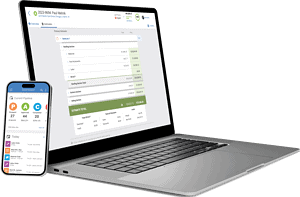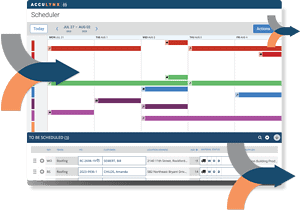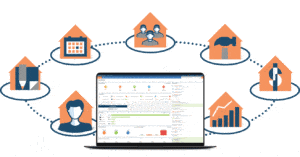As a roofing contractor, you’re focused on how to take your business to the next level. Using a roofing software program can help your company streamline workflows, improve customer service, and win more bids.
However, in order to get the most out of your software, you need to be using it effectively. Whether you’ve been using software for years or just getting started, we have outlined 8 tips to help you do so.

Tip 1: set up your software correctly
Before you start using your roof management software, you’ll need to make sure it’s set up correctly and optimized for your business processes
Some important things to do when initially setting up your software include:
- Enter your company’s information correctly
- Create templates for your estimates and invoices
- Customize your workflows by trade
The best roofing software programs recognize that the roofing industry is not a one-size-fits-all field, and enable you to create custom templates to run your business successfully.
As you’re setting up your software, you should also customize your workflows by trade. For example, if your business does roofing, siding, and gutters, having different workflows for each can give you better insight as to what is needed for a particular trade and job.
Now we know there’s more to it than just setting up templates and customizing workflows. That’s why you need to be working with a roof management software that provides ongoing training and customer support so that new employees can easily get up speed, and current users always have access to materials and updates
Tip 2: use the roofing software program to track your leads and opportunities
Your leads—especially those that turn into customers—are the lifeblood of your business. That is why it is important to keep your leads organized and follow up with potential customers, so you don’t waste time pursuing bad leads or lose out on business.
Using a roofing sales tool to identify which leads are most likely to turn into customers will take the guesswork out of lead qualification and save you hours each week on sifting through every lead that comes through, or pursuing a lead that would never turn into a customer.
Following up with qualified leads in a timely manner is even more important than generating a large volume of leads. Knowing which leads to go after gives you the time you need to do that.
Another tool you can use that helps with your lead tracking is your software’s dashboard to see the status of your leads in one place. This gives you insight into how many leads are in the pipeline, who has been followed up with, who has been invoiced, etc.

Tip 3: use the software to create and track estimates
Using roof management software to create your estimates not only saves you time, but also helps ensure what you present to the homeowner is accurate.
This starts with knowing the price of your materials from your supplier. Pricing and availability on these products can fluctuate, and not knowing that there has been a change can lead you to providing an inaccurate estimate.
Roofing software programs can pull in real-time pricing and availability from material suppliers like ABC Supply, Beacon, and SRS Distribution. This eliminates the need to check your price sheet, or having to call and check with your supplier.
On top of that, ordering too much or too little material is its own headache. But when your roofing software includes aerial measurement integrations from providers like EagleView or GAF QuickMeasure you no longer have to get on the roof and manually take measurements which can be error-prone. Taking advantage of aerial measurement integrations will give you comfort that the measurement is accurate and in turn, that you’re ordering the right amount of materials to complete the job.
Roofing software programs also enable contractors to track the status of their estimate. Having the ability to see your estimate is reviewed and when the customer signs it can help keep jobs on track. Estimates are stored in the job file, minimizing the risk of losing important paper documents, and having to dig through files to find it later on.
Add a few sentences about how roofing software programs enable contractors to track the status of their estimate.
Tip 4: integrate your software with other tools
Roofing software integrations go beyond material supplier and aerial measurement integrations. The best roof management software integrates with a number of tools that can help you run your roofing business more efficiently. By taking advantage of these integrations, you can streamline your workflows and continue to save time and make more money.
Other integrations that can help you have more control of your business operations include:
- Lead generating services
- Integrating with lead-generating services automatically syncs your leads between your roof management software and the third party, saving you time from having to enter contact information in multiple places, and avoid double data entry.
- Canvassing apps
- Canvassing app integrations help you find new leads, keep track of existing leads, assign salespeople to geographic areas, and monitor sales performance.
- QuickBooks
- An integration with QuickBooks simplifies your roofing company’s accounting process, reducing errors and automatically syncing customer information between the two programs. This allows you to accurately track your spend, profits, and more.
- And more!

Tip 5: use the software to schedule your jobs
You can use your roof management software to schedule your jobs to ensure that all of your crews are working efficiently and meeting deadlines. Utilizing shared production calendars, labor, and work order managers help make sure everyone has the information they need–and allows you to make changes on the fly.
A shared production calendar gives you the insight you and your teams need to know when work is being performed, when materials are getting delivered, and see in real-time if anything gets delayed or rescheduled. It also gives you an accurate picture of which crew is available to take on a job.
With a paper-only or whiteboard-focused approach, information can easily be entered incorrectly, and communication can have gaps. Roof management software keeps everyone in the loop and helps projects stay on track.
Tip 6: take advantage of automations
It’s easy to forget things. As a contractor, you know how busy you can get with high level tasks that need your focus, and administrative work like sending appointment reminders, alerting team members to pull permits, and more can slip through the cracks. Your roofing software program can automate a number of internal and external tasks just like these so nothing gets missed and you can free up your time to focus on other areas of your business.
You can schedule automations to run based on events that are triggered at different points of each job. For example, you can set up a “confirm your appointment” text or email, which can automatically be sent after you set the appointment in your roof management software. You can also use automations to manage internal tasks, such as sending your team order reminders or notifications when an order has been placed or delivered.
Automations can save you hours each week, and the best part is that the automations can be customized to how your business works best and what you need in order to be efficient.

Tip 7: use digital payment processing for convenience
Homeowners prefer to have multiple payment options and expect to be able to pay online. Using roof management software to offer this can make the payment process more convenient for everyone.
Digital payment processing is not only more convenient but gets you your money much quicker. You can process credit cards, debit cards, ACH payments, and e-checks in person, online, or over the phone. It’s a secure way to get paid on time and make the process hassle-free for you and your customers.
And if you’re taking advantage of the QuickBooks integration, these payments are automatically reflected in your account right away. Payments are also reflected in the homeowner’s job file, so you don’t have to worry if you cashed that check, or remember to enter the information manually.
Tip 8: use the software to track your expenses
Your business will always have expenses. Using roof management software to track your payments received, expenses, create estimates, send invoices, etc. will give you an accurate sense of how your business is performing since you have it all in one place.
Running weekly or monthly reports will help you stay on budget and make sure you are profitable. And be sure to use the pre-built reports your software has to offer to save time on staying on top of KPIs and having a reporting dashboard so you can see all your data in one place.
Doing so will let you see which jobs are performing the best, which salespeople are selling the most jobs, and where you’re spending too much money, and more.

Start using roof management software today
Using a roofing software program can be valuable for any roofing company. There’s no need to still be using paper, spreadsheets, or multiple software programs, when everything you need can all be in one place.
By following these tips, you can get the most out of your roof management software and improve your business.
Schedule a demo of AccuLynx today to see how our software can take your business to the next level.